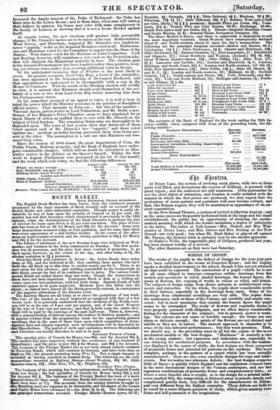SCHOOL OF DESIGN.
The works of the pupils in the School of Design for the year just part have been exhibited in the rooms at Somerset House • and the display marks a decided improvement in the school, though it has not yet attained all that could be expected. The curriculum of a pupil—which he is not in all cases obliged to traverse—comprises outline drawings from fiat models and specimens in relief, shaded drawings, the human figure, the study of flowers, the copying of works in colour or relief, and design. The subjects of design range from chintz patterns to architectural orna- ments and statuettes. • On the whole the pupils show considerable merit in their labours, especially in the whole, from casts. Some of the drawings from ornamental mouldings are very able. The copies from the arabesques, such as those of the Vatican are carefully and neatly exe- cuted ; but in most specimens that contain the human figure the pupil seems to be overtasked. The study of flowers and vegetable forms is very properly pursued with diligence, and we often descry considerable feeling for the character of the original; but in general, power is want- ing: the colours are not exact or forcible enough ; the forms are not sharp or delicate enough; the petals of the flowers are not distinct and subtile as they are in nature. The nearest approach to character is in some of the less laboured performances; • but they want precision. That,
i -we should say, the prevailing want in all but the copies of the most
mechanical models or the best designs. " Hardness " is scarcely a vice in the young student; but vagueness and indecision are, especially in one studying for mechanical purposes. In accordance with the tenden- cies displayed in the course-of study, the best designs are those composed of geometric forms and intended for patterns on fiat surfaces. The most complete, perhaps, is the pattern of a carpet which has been actually manufactured ; there are also some excellent designs for rugs and table- covers. But wo notice two alternate defects : the best designs comprise little of fancy—a quality which Raphael and his coadjutors evinced even in the most mechanical designs of the Vatican arabesques and are but ingenious combinations of geometric forms and complementary tints; or where a more fanciful idea is sought, as in the design for a printed table- cover marked 862, the composition is frittered away in minute details and complicated patchy tints, very difficult for the manufacturer to follow, and very different from the highest examples. These defects are both to be cured by a more diligent precision of study, which gives mastery over forms and self-possession to the imagination.


























 Previous page
Previous page